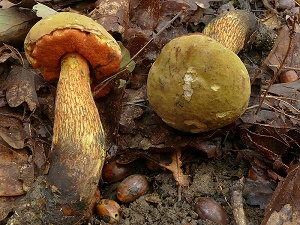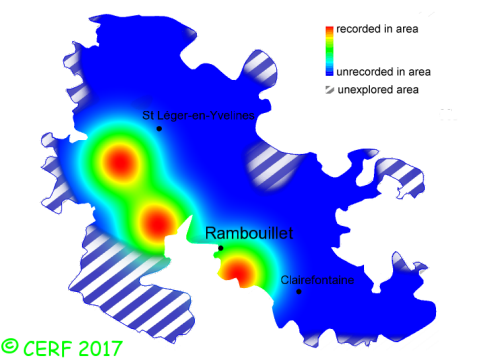| Boletus luridus Schaeff.:Fr. |
|
|
|
|
|
|
The cap is of variable colour, hard to define : buff-green, dirty yellow to pale brown, reddish at animal bites, fleshy, thick, of convex shape, getting more or less flattened. The cap surface is dry, matt, downy then smooth. The cap margin is inrolled young, then more or less irregularly wavy. The stem is sturdy and full, more or less equal or swollen at the base, slim or on the contrary stocky (short and swollen in young specimens). It is yellow at the top, orange-yellow then brown towards the base (the stem looks like being red, because of the blood-red network). The stem turns blue strongly when touched, particularly in the youth. It is covered with a blood-red (brown with age) network with large mesh cells elongated towards the base.. The flesh is thick, firm, pallid to apricot yellow, reddish in the stem base. It turns green-blue quickly when in contact with air. Interesting identification criterion of this species: when cutting off a slice of the cap, just before the change of colour to blue, a fine red-orange line can be seen just above the tubes, on the yellow background of the flesh.; its taste is mild or faint; the odour is pleasant or weak; The tubes are thin, free, removable in small blocks, long (20-35mm), yellow then greenish, round, turning blue-green when exposed to air. The pores are small, round, orange-red (red very early), then yellowish when getting paler with age, turning strongly dark blue when pressed. The spore print is dark olive brown. It grows in well ventilated areas of coniferous or deciduous woods: woodlands, pathsides, clearings or wood edges, but also in parks, on a rather rich, calcareous or neutral soil, with beech, oak, birch. The fruiting period takes place from April to November.
Chemical tests : positive reaction to iodine (flesh becoming dark blue) and to ammonia (flesh becoming ochre). Distinctive features : when cap sliced, a red marking on yellow background appears just above the tubes, before the flesh turns intensely blue; raised blood-red network on stem, the mesh being stretched towards stem base; brownish cap; red pores, turning quickly deep blue when pressed Boletus luridus is quite rare and localised in the forest of Rambouillet, and is occasional, more generally speaking . | ||
|
page updated on 14/01/18

